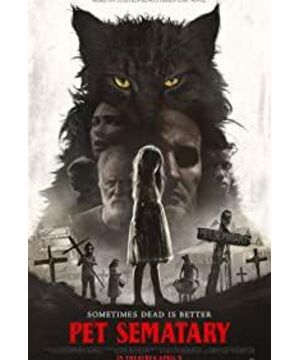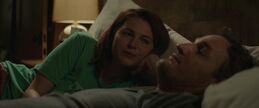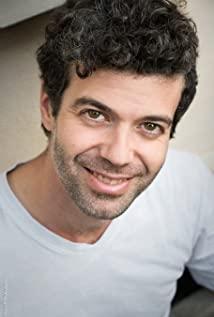What I think when watching the old version of the pet cemetery is: Lao Jin rarely seduce readers to wake up to any truth, he just wants to tell a horrible story, like taking you to a dark basement to see you stumble and groping inside, you When he was about to cry, he covered his mouth and laughed. Finally, he takes your hand and brings you back to the sun. As for whether you will continue to worry about the basement after you come back, he doesn't care. (This is what he said in the preface of the book Dark Night Without Stars)
But he didn't want to cry the readers.
Why are Lao Jin’s remakes of third-rate horror movies? Including The Clown’s Soul, I don’t believe that people who like the original will appreciate the new version of the movie. It feels like stacking a bunch of horror elements in the original work dryly and pointing to it and saying to the audience: Look, you are scared to death!
I'm sorry, if I want to find visual stimulation, I won't come here.
The plot of the new version of Pet Cemetery is simply sparse. It neither has a good understanding of what the original is meant to express, nor can it compare to the old version's shaping of the atmosphere.
First of all, let's talk about the role of clues, the old neighbor Zade.
Why did Zade bring the pet cemetery into the life of this family?
In the original work, it was the daughter who first discovered a path and then asked the old man where the road leads. The old man took the family to hike wherever he felt happy, which caused his daughter's discomfort with the concept of death. Later, Zade's old wife suffered a sudden illness, and the male protagonist rescued it. Because of this gratitude, Zade decided to tell the man the secret of the Indian grave behind the pet cemetery. In the new version, the role of Zade’s wife is cancelled, which makes Zade’s behavior very abrupt. Is he willing to take such a big risk based on his love for the little girl?
Well, even if his love for little girls prevails, let's talk about the timing of burying cats.
In the original work, the hostess took his sons and daughters back to her natal home. The host didn't go because he had a bad relationship with his father-in-law (this detail is also very important). When he was alone at home, the cat was hit and killed by a car. Zade’s idea is: Let’s try to bury it first.
Why does he think so? Because many people have buried pets there, including himself. Some pets have not changed much since they were resurrected, some become ferocious, and some just become dull and dull. Zade’s own dog is the last situation, so he wants to bet if the cat doesn’t change after returning. Big, then you can fool around and comfort the little girl. (Actually, after the cat came back, apart from being a little dirty, having a weird temper, and not being violent towards the little girl, so the male lead didn’t care about it)
In the new version of the setting, the resurrected animals will definitely get worse. Zha Deming knows that he still has to do it, and he has to do it when the girl is at home, which makes it hard to understand...
After the kitten came back, he was confused, so Zade was relieved. As a result, the male protagonist inadvertently asked "has anyone buried anyone there" while drinking. He was frightened and was noticed by the male protagonist. The clues. When the little boy was hit and killed by a car, Zade heard that the male protagonist had set a semi-closed tomb (which can be dug out with a shovel), and realized that things might be out of control, and quickly explained the past events to the male protagonist in detail. This story works well in the old version: there is a man who buried his child there, but the one who returns is the devil.
The male protagonist was also very frightened, but the heart of thinking about children prevailed. He sent his wife and daughter back to his father-in-law’s house, and then decided to take the risk and kill the resurrected son again. He didn’t expect to dig his grave all night. Too sleepy, went home and fell asleep, which made things completely out of control.
But the male protagonist in the new version is a stupid... he didn't think about the question of whether his daughter was a human or not at all, so he slept with his daughter without any qualms and listened to the gods in her mouth. God talks, still let it go. In the end, they become a zombie family. It can only be said that the pot is on the male lead.
In other words, in the original version, what you see is that the male protagonist is always on the verge of danger, and the emotional substitution is in place, so that you are both worried and pitiful for him; what you see in the new version is that the male protagonist has been crazy on the mines. Bundi (.
Then let's talk about those places where it is extremely scary to think carefully.
For example, in the original work, the daughter was crazy about the concept of death, enough to make readers think about it. Of course, the book is from the 1980s, and it may not be too scary to read it now. Different people have different opinions.
There is also the story of the heroine and her sister who died young. In the original story, the heroine also went crazy after her daughter went crazy. It was because of her sister's death that she caused a psychological shadow: a little girl who took care of a sick and inhuman form for a long time. Sister, one day the adults were not at home. Sister didn't come up and died on the bed. She was the first to find out. She tried to rescue her but couldn't get it back. This made her terribly scared on the one hand, on the other hand secretly relieved, and at the same time, because of this relief, she has self-loathing—the delicate aspects of this emotion are worthy of the reader's taste. In the new version, the drama was changed to the heroine because she was afraid not to deliver the meal. As a result, she inadvertently caused the consequences of her sister falling down the elevator shaft, turning the fear of death into the fear of "causing the death of others", weakening the emotions. , In exchange for only close-ups of horror scenes in third-rate horror movies, there is no need.
Finally, talk about the pet cemetery itself.
The pet cemetery in the original work is a place of sorrow that "every child knows, but not all adults know". The children spontaneously bury their pets and cut the grass regularly. There is a very interesting description, saying that children are arguing about who is responsible for carrying the coffin. The pet owner thinks that his friends should carry it, and the two children who helped make the coffin think that they should carry it by themselves. The pet owner is very dissatisfied and said It was relatives and friends, not carpenters, who carried the coffin. The last child who had an encyclopedia at home decided that the number of people in the book was unlimited. That was the joy of everyone, and a decent funeral was held.
The details of the old version of the movie are in place. Children spend their energy to engrave inscriptions on the stone, and put their pet's favorite toys by the tomb, showing a sense of innocence. The new version doesn’t know what to think, it’s like a cult. It asks children to wear weird animal masks and put dead dogs on the carts... and then the animal masks became the costumes of girls when they killed people. play.
Under this kind of arrogance, the audience sees only the director’s mystical "This land is terrifying, it brings you ghosts back, see how ghosts toss you", but in fact, if Lao Jin wants to express something, What he wants to express should also be the passages quoted before each chapter in the original work: You think it is "resurrection, Lazarus", but in fact it is "whatever needs to be answered, but those who respond do not ask" in "Monkey Paw". (In fact, many of Lao Jin's works express this: Don't be cheap, do you think what you think is what you think?)
As for the most changed ending plot, there is nothing to say, this is not called adaptation, this is called rewriting. The audience of the old version of the movie is discussing whether the heroine wields a knife to stabbing the hero, or the heroine in the original voice calls the hero strangely, the new version... Isn't this the most important thing for the family in the legend to be neat and tidy?
View more about Pet Sematary reviews











